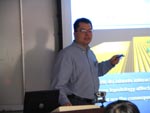Research Activities >
Programs >
Nonequilibrium Interface and Surface Dynamics 2007
|
|
Self-assembly of Nanostructures on
Topographically Pattern Substrates
CSIC Building (#406),
Seminar Room 4122.
Directions: home.cscamm.umd.edu/directions
|
Self-assembly of Nanostructures on Topographically
Pattern Substrates
Professor
Robert Kukta

State University of New York at Stony Brook
|
|
Abstract:
A large obstacle to taking nanotechnology from the
research lab to the consumer market is the
development of low-cost techniques for fabricating
stable and device-specific nano-scale structures.
One candidate is self-assembly, whereby a desired
structure is allowed to form by natural processes.
Self-assembly is an old technologyalloys like steel
are regularly heat treated to form particular
microstructures that exhibit high strength and
toughness. However, controlling self-assembly by
heat treatments and similar weakly guided processes
is limited, as few and only very simple structures
are possible. Techniques with greater flexibility
and control are needed to fabricate devices of even
modest levels of complexity. A promising route to
controlling the formation of nanostructures is
combining self-assembly with well-established
techniques for patterning at the micro-scale.
Relatively large-scale features provide a template
for the organization of smaller features. The
problem and topic of this talk is to determine what
are the large-scale features needed to drive the
formation of a particular nanostructure. Focus is on
the self-assembly of material deposits (quantum dots
or islands) grown by strained-layer epitaxy on a
topographically patterned substrate. Prior to
growth, features are introduced on the substrate by
a method such as lithography and ion-etching. These
features guide morphological development by
providing preferred sites for islands to nucleate
and grow. While it is known from experiment that the
arrangement of islands on patterned substrates is
affected both by energetic and kinetic phenomena,
the nature of these effects has not been well
characterized. There have been few analytical and
computational efforts to understand where islands
form and why and how they develop at particular
sites. This talk offers some new insight, drawn from
continuum and mesoscale models and simulations. The
focus is on structures that form on two-dimensional
sinusoidal patterns and three-dimensional raised
mesa patterns. |
|